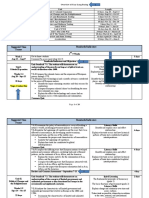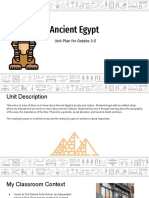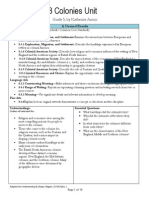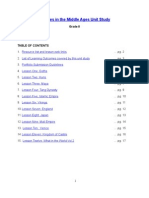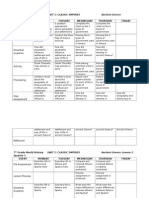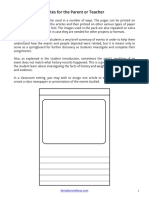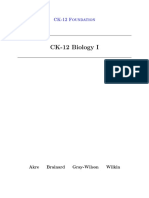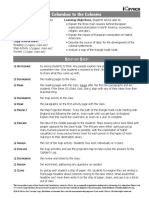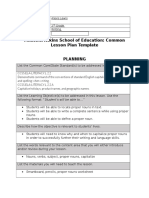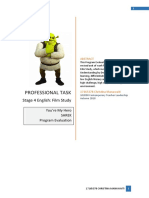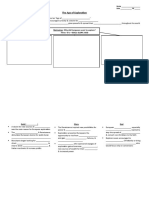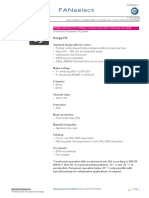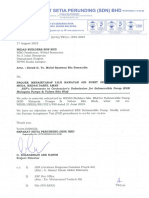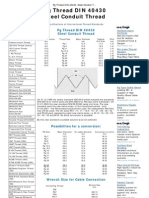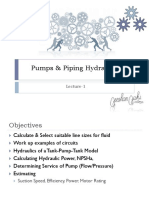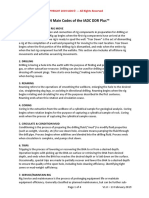LESSON PLAN TEMPLATE
GENERAL INFORMATION
Lesson Title & Subject(s):Where did we come from, where did we go?
Topic or Unit of Study: Social Studies: Early Man
Grade/Level: 6
Instructional Setting:
27 students in 6 groups of 4-6
STANDARDS AND OBJECTIVES
Your State Core Curriculum/Student Achievement Standard(s):
6.1.1. Describe hunter-gatherer societies, their development, and use of fire.
6.1.2.
Lesson Objective(s):
Students will identify at least 4 regions where early humans migrated to and formed communities
(Africa, Asia, Europe, Australia, North America, South America).
Students will label on a map where certain types of early humans lived, designated by color and
name with 100% accuracy (Australopithecine, H. habilis, H. erectus, H. neanderthalensis, H.
sapiens).
MATERIALS AND RESOURCES
Instructional Materials:
World Map in the INBs
Smartboard
Harcourt 6th grade textbook teacher guide
Resources:
Human evolution faces side-by-side:
https://thumbs.mic.com/N2YwZGRjMWU2OCMvNDkzbkprWktfWEh1UDdQbzlsNVNfbVNLdWlrPS8x
NjAweDkwMC9maWx0ZXJzOmZvcm1hdChqcGVnKTpxdWFsaXR5KDgwKS9odHRwczovL3MzLmFt
YXpvbmF3cy5jb20vcG9saWN5bWljLWltYWdlcy82N3JnZmZ4dmY2aW02MHV5MnZmZmdwNGhmY
zNtZm5lZzZvZDIxdnB3bng1YXNrdWFieXBka252YXJhbGZscDFnLmpwZw.jpg
INSTRUCTIONAL PLAN
Sequence of Instructional Procedures/Activities/Events (provide description and
indicate approximate time for each):
1. Student Prerequisite Skills/Connections to Previous Learning:
Students will read Peter, a Late Paleolithic boy, keeping a mind to how his tribe has adapted to
their cold environment.
�2. Presentation Procedures for New Information or Modeling:
I will ask the students to recall how early man was nomadic, as I show
them a map of where the first humans lived. I will tell them that we call
the first humans Australopithecus Africanus, and have them think,
minding their context clues, of where they lived based on their name. I
will let them know that when Anthropologists name new things they
discover, they often base the names on where they found them. I will tell
them about H. Habilis, and how that was the first kind of human to
develop crude stone tools and shelters. I will tell them about H. Erectus,
and how that one came later and did a lot of things first (burials, fine
tools, fire, cook, mud shelters, and to migrate out of Africa) thanks to its
larger brain. I will tell them how H. Neanderthalensis made the first
clothes, made the first cave paintings, and jewelry. I will finish by telling
them about H. Sapiens, and how it made the finest tools, migrated faster
and farther than any others, and lived at the same time as Erectus and
Neanderthalensis during the Ice Age.
3. Guided Practice:
Well work on a group map, wherein I will ask students to consider first A. Africanus and where
they believe it lived. I will ask them to consider what they know about the first humans to
migrate to determine where Habilis lived. Ill then guide them through the migration paths as
they name continents, and remind them of when we looked at the paintings in Lascaux cave to
determine which humans lived there (the first painters). Well continue to do this all the way
through to Sapiens.
4. Independent Student Practice:
Students will label their maps according to color where each set of humans traveled, their
migration paths, as well as coloring in where rivers and lakes existed. We will come back to
these maps as we study the first cities. They will know not to write in the names of continents.
Students may work with partners on individual work, so that they may consult each other as
they work through their ideas of which humans lived where. Students will be prompted to use
specific colors to label different humans.
5. Culminating or Closing Procedure/Activity/Event:
We will watch a video wherein which a stone age reenactor cultivates a sweet potato patch in
South America using Stone Age practices. This is a link to how future communities of mankind
moved away from migrating and hunter-gatherer life and into settled communities.
Instructional Strategy (or Strategies):
Direct Instruction
Differentiated Instruction Accommodations:
Describe accommodations for such groups as English Language Learners, students with learning
disabilities, students with hearing or physical disabilities, and/or gifted/accelerated learners.
Use of Technology:
Teacher or student
Student Assessment/Rubrics:
�Describe how you will know if students have met the objective(s) for this lesson (include pre- and
post-assessment plansformal and/or informal, summative and/or formative, etc.).


